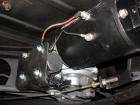|
Re: Starting problem, starter vs. ring gear
|
||||
|---|---|---|---|---|
|
Forum Ambassador

|
What ever else may be requiring attention, you're certainly going to have to replace the ring gear. Damaged tooth could be due to several reasons; original manufacturing flaw, excessive leverage when someone use the teeth as leverage points to turn the engine over, and/or too many harsh engagements from 12-volt jumps. That's not an entirely uncommon problem with folks who convert to 12-volts but retain the original 6-volt starter.
Usually you can break the old ring gear off with a chisel. New rings are then heated to expand them before placing back on the flywheel. I think there were some pictures of this procedure on this site recently - perhaps a search will locate them. Not a bad job though it does require a bit of diassembly first. PS - Opps, just noticed you said automatic. Disregard with rsspect to changing ring gears.
Posted on: 2011/10/1 13:33
|
|||
|
||||
|
Re: Starting problem, starter vs. ring gear
|
||||
|---|---|---|---|---|
|
Home away from home

|
2 choices. Cross your fingers and do nothing. Replace ring gear.
There is a third choice, take off starter and file or grind end of broken tooth to a point or round it off. This to prevent the gears jamming if it come up again.
Posted on: 2011/10/1 13:35
|
|||
|
||||
|
Re: Starting problem, starter vs. ring gear
|
||||
|---|---|---|---|---|
|
Forum Ambassador
|
If Ultramatic, used flex plates should be easily found. If standard at least Max lists the ring gears -- but not the cheapest thing to change. Is that the type ring that can be turned around or is there not enough of the tooth left to do that.
Posted on: 2011/10/1 14:04
|
|||
|
Howard
|
||||
|
||||
|
Re: Starting problem, starter vs. ring gear
|
||||
|---|---|---|---|---|
|
Home away from home
|
Have many nice flex plates. $40 plus shipping. PM if interested.
Posted on: 2011/10/1 15:02
|
|||
|
||||
|
Re: Starting problem, starter vs. ring gear
|
||||
|---|---|---|---|---|
|
Home away from home

|
Owen has a good point about harsh engagement, on 12 volts the starter spins much faster and really slams into the ring gear.
Car makers went to a finer tooth gear for this reason, when they went to 12V/ It might be a good idea, if you are changing the flex plate, to use a 12V flex plate and starter.
Posted on: 2011/10/1 16:00
|
|||
|
||||
|
Re: Starting problem, starter vs. ring gear
|
||||
|---|---|---|---|---|
|
Home away from home

|
Hello everyone, thank you for replying. FYI, the car is 6V pos ground. The starter and flexplate have been "together" for at least 10 years.
Rusty O'toole' "There is a third choice, take off starter and file or grind end of broken tooth to a point or round it off. This to prevent the gears jamming if it come up again" Thanks for that tip, I really don't want to change the flex plate, (I really mean REALLY). In your opinion, if I'm able to reshape the broken tooth and everything works and sounds good, will I be harming the ring gear or starter any further? Is the loss of part.....say, 50% of the tooth that big a deal in the long run? Your thoughts please. "by Ross on 2011/10/1 13:02:06 Have many nice flex plates. $40 plus shipping. PM if interested." Thank you I'll do so.....just in case.
Posted on: 2011/10/2 12:59
|
|||
|
Steve
Old cars are my passion  1951 Packard 200 1953 Packard Clipper Custom Touring Sedan 1955 Dodge Custom Royal Lancer Tri-tone 1966 Rambler Classic 770 Convertible |
||||
|
||||
|
Re: Starting problem, starter vs. ring gear
|
||||
|---|---|---|---|---|
|
Home away from home

|
There are around 100 teeth on the ring gear, chances are it will not hit again for a while although it will eventually. If the end is tapered the starter can engage without jamming. This is not a proper repair but may prevent it from jamming again.
Other factory manuals (not Packard) say the ring gear teeth can be worn off up to 25% and no harm done. If they are worn down half way they recommend a new ring gear. I expect Packards are the same.
Posted on: 2011/10/2 14:36
|
|||
|
||||
|
Re: Starting problem, starter vs. ring gear
|
||||
|---|---|---|---|---|
|
Forum Ambassador

|
With 1/2 the strength of the original tooth lost, it's a crap shoot as to when the remaining fragment fails, but I suspect it will and probably at the most inopportune time and place. I'd rather fix it at a time and place of my own choosing, but as has been said, not a trivial job.
Posted on: 2011/10/2 19:02
|
|||
|
||||








